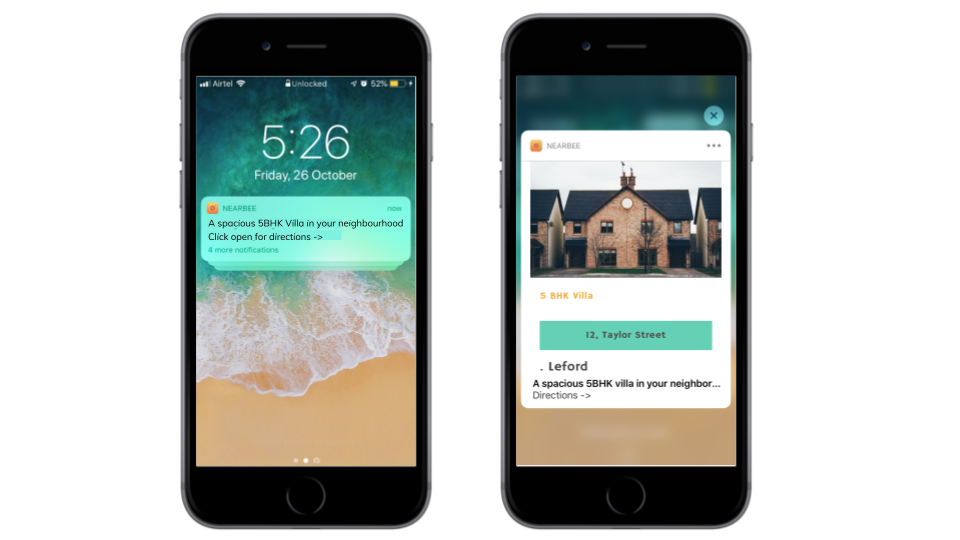How to Improve Your ROI with Geofencing Marketing
Imagine going downtown to meet some friends for lunch. While you’re trying to decide where to go, you receive a notification as you pass by a restaurant you tried a few weeks ago offering a discount. The decision now becomes a lot easier for you and your friends and the restaurant gains new customers.
This win-win scenario is made possible with geofencing marketing technology. Using GPS and Bluetooth, battery-powered beacons (installed at a business) work together with location services in smartphones passing within a certain radius, or geofence.
Let’s take a look at geofencing marketing technology, how you can use it and some testing strategies.
What is Geofencing Marketing?
Geofencing has been around for years, but the proliferation of smartphones and mobile devices has transformed it into a valuable marketing tool. By combining push notifications and ads with specific locations, businesses can reach a targeted audience and improve their return on investment, or ROI.
There are two types of geofencing marketing that businesses can use depending on their marketing or advertising objectives.
Download our free checklist of geofencing marketing platforms to power your campaigns.
Localization
Localization lets businesses set up a geographic boundary to reach potential customers in the area. Unlike beacons, localization can be customized to reach customers in specific cities, states, regions or even other countries. The idea is that you’re customizing the user experience based on location.
Mobile apps and websites can request that a user share their location from a smartphone or browser, or their location can be found using their IP address. Using this information, you can customize marketing messages on your website or better target advertising campaigns — and it only takes a few lines of code to implement in many cases!
For example, an outdoor apparel manufacturer might change their homepage based on a visitor’s state. Visitors from Colorado may be interested in skiing equipment whereas visitors from California may be more interested in surfing gear. International ecommerce websites may also show different languages and currencies based on location.
Beaconing
Beaconing transmits targeted messages to nearby mobile devices that have opted in to alerts through their operating system or third-party apps. For instance, Google Play’s Nearby API enables proximity and cross device communication. While the Android Nearby Notification service was discontinued, third-party apps can still leverage these capabilities.
Bluetooth low-energy (BLE) beacons are small Bluetooth radio transmitters that transmit signals within a small radius. Smartphones within range receive a ping from the beacon and send a unique ID number to a cloud server that can send an alert to the phone and/or tie the visitor to an online ID for remarketing purposes.

Example of Beacon Capabilities via NearBee
For example, a coffeeshop may send a discount offer to nearby potential customers. Or, a retailer might show an offer via a beacon to potential customers that come into the store and then embed a Facebook pixel that enables them to retarget that customer through Facebook ad campaigns. This can have a big impact on advertising ROI.
How to Use Geofencing Marketing
Geofencing marketing is a great way to reach new customers or improve conversion rates with existing customers, but these are only scratching the surface of what’s possible. Localization and beaconing can be powerful analytical tools to help improve both online and offline performance.
Download our free checklist of geofencing marketing platforms to power your campaigns.
Let’s take a look at three common use cases for geofencing marketing technology.
#1: Improve Your ROI
Local optimization is extremely valuable for small businesses. While search optimization is difficult and time consuming, geofencing marketing lets you target customers in their local geographic area with little effort. You can even change promotions and customize offers using a variety of geofencing platforms.
#2: Measure In-Store Sales
Point-of-sale transactions are harder to measure than online transactions because there’s nothing to tie an online marketing campaign to a point-of-sale transaction. You can create this connection with geofencing marketing and BLE beacons, as well as measure the return on investment of online campaigns with local shoppers.
#3: Generate New Analytics
You can aggregate information from geofencing marketing efforts to personalize offers and make in-store decisions. For instance, you may realize that most customers respond to certain product offers and use those insights to rearrange in-store displays. Or you may find that certain customers respond to certain offers and adapt your messaging.
GeoIP Testing Strategies
Businesses that want to test their geofencing marketing efforts, and localization in particular, use proxy servers. By connecting to their website or app from different locations, they can verify that the correct marketing messages are showing without any errors or other issues. The problem is that this is a time-consuming and error-prone process.
The best way to test localization marketing efforts is using automated tests. For example, an ecommerce website may create a test in Selenium that automatically connects from various locations and ensures that the messaging and marketing offers are correct without having a QA person manually connect and check each individual page whenever a change is made.
WonderProxy makes it easy to develop these automated tests with its reliable network of proxy servers around the world and easy-to-use API. In addition, marketing teams can use the same service to connect to multiple locations to test ad campaigns without dealing with unreliable and insecure free proxy servers.
The Bottom Line
Geofencing marketing is a great way to improve the return on investment of your advertising and marketing efforts. Depending on your business, you can use the technology to target local visitors passing by your local storefront or customers in specific states or regions. The key to success is ensuring that it’s working and collecting the right data.
Sign up for WonderProxy today and see how it can help you improve your localization testing!